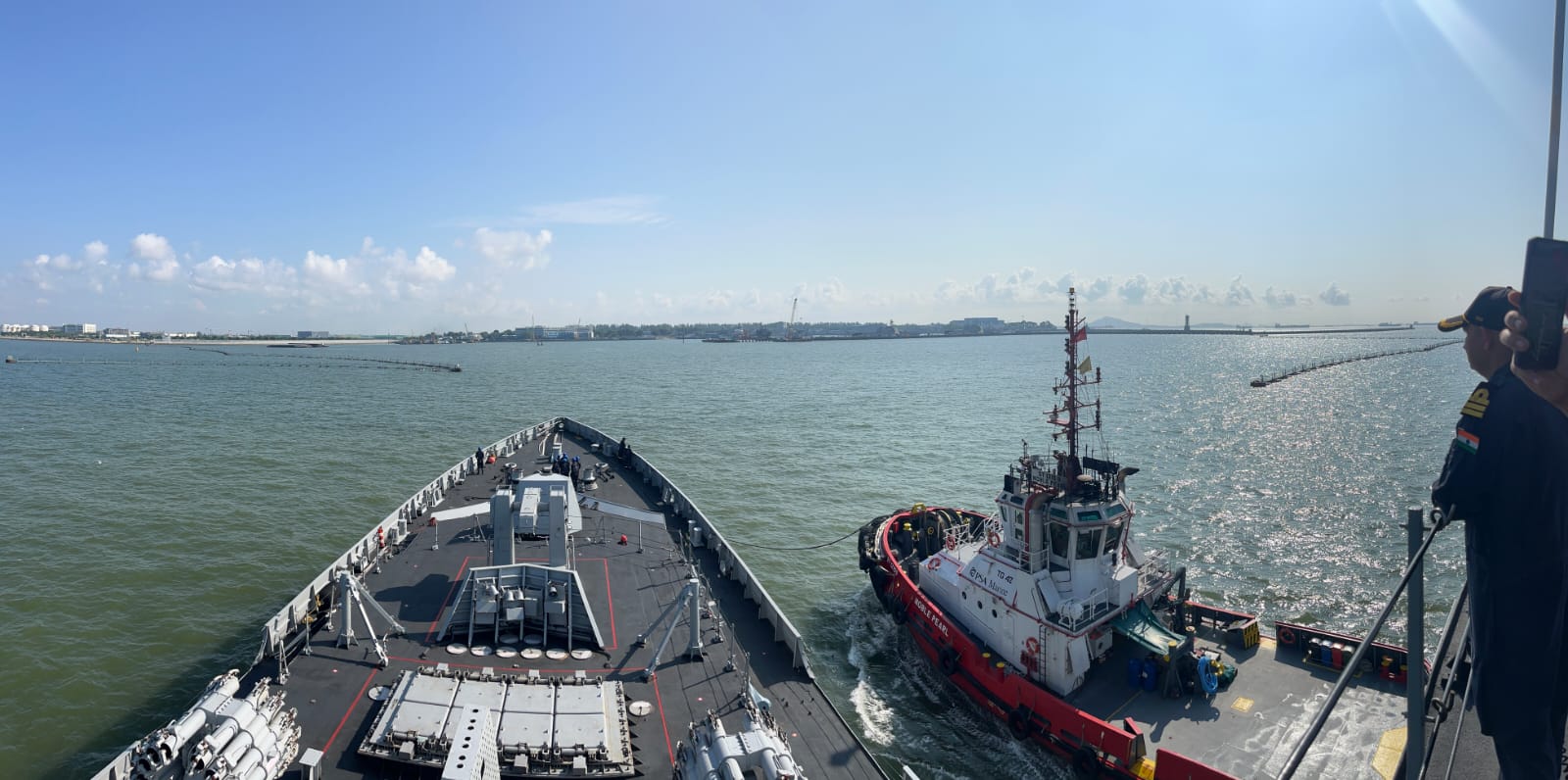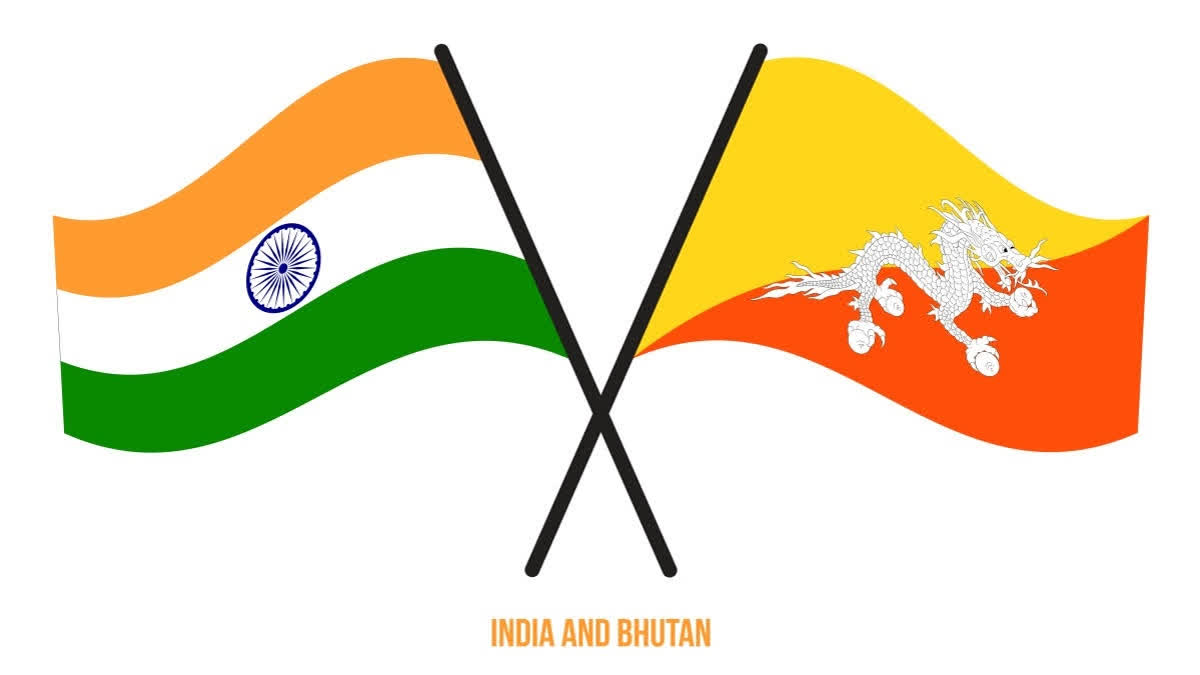SIMBEX-25

- 01 Aug 2025
In News:
- The 32nd edition of SIMBEX—India’s longest continuously conducted maritime bilateral exercise—was held from 28 July to 1 August 2025, hosted by Singapore. It included a Harbour Phase at Changi Naval Base and a Sea Phase in the southern South China Sea.
- Indian participation: INS Satpura, alongside INS Delhi, INS Kiltan, and the support vessel INS Shakti.
- Singapore Navy elements: RSN Vigilance and RSN Supreme, supported by MV Mentor and aerial units—S-70B Seahawk, Fokker-50 aircraft, and F-15SG fighters.
Objectives & Activities
Harbour Phase
- Featured Subject Matter Expert Exchanges (SMEEs), professional presentations, and strategic interactions.
- Conducted deck familiarisation visits aboard respective ships to foster doctrinal alignment
Sea Phase
- Encompassed advanced drill sequences, including:
- Air defence exercises, cross-deck helicopter operations
- Precision targeting, complex manoeuvres, and VBSS operations (Visit, Board, Search, and Seizure)
- Concluded with a ceremonial sail-past, symbolising professionalism and unity.
Geopolitical Landscape
- Strategic Reach: Deployment of Indian vessels to Philippines and Vietnam — alongside participation in SIMBEX—demonstrates India’s extended operational posture in Southeast Asia amidst regional tensions, notably with China’s maritime assertiveness.
- Broader Continuity: The Indian Navy, operating via the Andaman and Nicobar Command, employs SIMBEX as part of a broader matrix of maritime outreach in the region, including CORPAT and MILAN exercises
Sawalkote Hydroelectric Project
- 01 Aug 2025
In News:
In a strategic shift, India has floated international tenders for constructing the long-stalled Sawalkote Hydroelectric Project (1,856 MW) on the Chenab River in Jammu & Kashmir, leveraging the fact that the Indus Waters Treaty (IWT) with Pakistan is currently in abeyance. This development marks a significant turn in India’s water diplomacy and infrastructure planning.
Background & Project Details
- Location & Nature: Sawalkote is a run-of-river hydropower project near Sidhu village in Ramban district, J&K.
- Conception & Delay: Originally conceived in the 1980s, handed to NHPC in 1985, then returned to JKSPDC in 1997. Despite Rs 430 crore spent on enabling infrastructure, the project remained unstarted until a 2021 MoU revived it under an BOOT (Build-Own-Operate-Transfer) model.
- Tender Process: In July 2025, NHPC invited international bids (design, planning, engineering) with bid submissions due by September 10, 2025.
- Scale & Costs: Estimated cost stands at Rs 22,704.8 crore, set to be executed in two phases.
- Environmental Clearances: Forest Advisory Committee granted in-principle approval for diversion of 847 hectares of forest land.
Indus Waters Treaty (IWT) & Its Suspension
- Treaty Overview: Signed in 1960 (brokered by the World Bank), IWT allocates the eastern rivers (Ravi, Beas, Sutlej) to India, and the western rivers (Indus, Chenab, Jhelum) to Pakistan. India retains limited non-consumptive usage rights for hydro-power on these western rivers.
- First Suspension: On 23 April 2025, following a terrorist attack in Pahalgam, India suspended the IWT, citing national security and the treaty’s exploitation by Pakistan for cross-border terrorism.
- Consequences: India ceased hydrological data sharing, blocked Pakistani access to project visits, and released annual joint-status reporting—effectively halting treaty obligations.
- Strategic Intent: This pause grants India freedom to launch projects like Sawalkote without Pakistan’s prior objections or IWT constraints.
Geopolitical Tensions & Ramifications
- Long-term Impact on Pakistan: The Indus system sustains ~80% of Pakistan’s agriculture and electricity. Disruption could severely undermine food security, hydropower production, and urban water supply.
- Symbolism of a Rift: The treaty had survived wars and conflicts. Its suspension is viewed as an overt break in regional cooperative norms, with potential for conflict escalation.
- Legal & Diplomatic Fallout: Pakistan views reduced water flows as “act of war”; it is exploring legal avenues and appealing for treaty revival.
- India’s Firm Stance: PM Modi has labeled the treaty “unjust,” declared “blood and water cannot flow together,” further hardening India's negotiating posture.
Strategic Evaluation
- Violation or Tactical Move? While the IWT allows limited usage by India, its suspension indicates a focus on infrastructure autonomy over the western river system.
- Regional Domino Effects: With rising global water disputes, actions like this may set precedent in viewing water as geopolitical leverage.
- Environmental & Social Risks: Dam construction and forest diversion raise ecological concerns; plus, local displacement and compensation need careful handling.
Skill Impact Bond (SIB)

- 01 Aug 2025
In News:
- India is at the cusp of a demographic transition, with a young workforce expected to drive its goal of becoming a $30 trillion economy by 2047.
- Yet, only ~4% of India’s workforce is formally skilled, and nearly 30% of trained individuals remain unemployed. Traditional skilling schemes have struggled, especially with job retention.
- Against this backdrop, Skill Impact Bond (SIB), launched in 2021, marks a paradigm shift in India’s skilling ecosystem by linking financing to actual outcomes.
What is the Skill Impact Bond (SIB)?
- Launched: November 2021.
- Implementing Agency: National Skill Development Corporation (NSDC) under Ministry of Skill Development & Entrepreneurship.
- Partners: British Asian Trust, Children’s Investment Fund Foundation (CIFF), HSBC India, JSW Foundation, Dubai Cares.
- Target: Train 50,000 youth (60% women), ensure sustained employment.
It is India’s first development impact bond focused on employment, not just certification.
How Does SIB Work?
- Risk Investors (Private/Philanthropic): Provide upfront funds to service providers (training institutes).
- Service Providers: Deliver skill training, placement support, and post-placement mentoring.
- Outcome Funders (Govt/Donors): Repay investors if measurable outcomes are achieved (job placement + retention).
- Third-Party Evaluator: Verifies outcomes.
Key Distinction: Funding is tied to placement and retention, not mere enrolment/certification.
Progress So Far
- 23,700 youth trained across 13 sectors & 30 job roles.
- 72% women participation – one of the highest in any skilling programme.
- 75% placed in jobs, and 60% retained beyond 3 months, exceeding national averages (<10% under older schemes).
- Jharkhand, UP, Delhi are leading states in enrolment.
Significance
- Women-led Growth:
- 72% women trainees; many first-generation formal workers (tribal, rural, conservative households).
- Skilling gives women not just jobs but also agency, confidence, and identity.
- Outcome-Based Financing:
- Ensures accountability of training providers.
- Attracts private/philanthropic capital into public welfare.
- Addresses Retention Challenge:
- Traditional skilling: 84% complete training, but <10% stay in jobs beyond 3 months.
- SIB model pushes for long-term impact.
- Replicable Model:
- Can be scaled to health, education, social welfare.
- Example: Project AMBER (apprenticeship-based skilling) also uses this financing.
Challenges Ahead
- Scale vs Depth: Training 50,000 is significant, but India needs millions of skilled youth annually.
- Social Barriers: Women face mobility, safety, and cultural challenges in sustaining employment.
- Monitoring & Evaluation: Requires robust third-party systems to measure outcomes fairly.
- Private Participation: Sustaining investor confidence demands continuous success stories.
Way Forward
- Expand outcome-based financing to more sectors.
- Strengthen ecosystem for women (hostels, childcare, safe mobility).
- Continuous mentoring & alumni networks to ensure retention.
- Use digital platforms for scalable skilling and tracking.
Barbados Threadsnake (Tetracheilostoma carlae)

- 01 Aug 2025
In News:
The Barbados threadsnake, long considered lost to science, has made a startling comeback. This diminutive reptile—no longer than a coin—was rediscovered in Barbados in March 2025, nearly two decades after its last documented sighting. Its reappearance has reignited global interest in its conservation and the fragile ecosystems it inhabits.
Key Attributes & Taxonomy
- Scientific Classification: Tetracheilostoma carlae, family Leptotyphlopida.
- Size & Weight: Adults reach approximately 9–10 cm (3–4 in) in length and weigh ~0.6 g (~0.02 oz)—making it the world’s smallest known snake
- Physical Traits: Extremely slender—about as thick as a spaghetti noodle. Distinguished by pale orange dorsal stripes and a small scale on the snout
- Vision & Behavior: A blind, fossorial snake that burrows underground, especially hiding under rocks during the day.
- Diet: Feeds on termite and ant larvae—its petite jaws prevent it from consuming larger prey.
- Reproduction: Oviparous, laying only one large egg at a time, with hatchlings already about half the size of adults.
Rediscovery: A Significant Scientific Moment
- Context: The species had not been observed since 2006, and earlier specimens were often misidentified in museum collections.
- 2025 Rediscovery: During a March ecological survey in central Barbados by the Ministry of Environment and Re:wild, the snake was found under a rock near a jack-in-the-box tree. It was confirmed after microscopic and morphological assessment at the University of the West Indies.
- Reactions: This turn of events is hailed as a conservation triumph and a poignant reminder of Barbados’s biodiversity despite its heavily altered landscape.
Conservation Context & Implications
- Habitat Loss: Over 98% of Barbados’s primary forests have been cleared, leaving threadsnake habitats limited to a few square kilometers of secondary forests, particularly in the Scotland District.
- Threats: Loss of habitat and competition from the invasive Brahminy blind snake (Ramphotyphlops braminus), which reproduces asexually and may outcompete the threadsnake.
- Conservation Action: The rediscovery falls under the broader Conserving Barbados’ Endemic Reptiles (CBER) project. Future plans focus on mapping its range, safeguarding habitats, and preserving biodiversity as part of Barbados's compliance with the Kunming-Montreal Global Biodiversity Framework.
Dorjilung Hydropower Project

- 01 Aug 2025
In News:
India and Bhutan share one of the most successful models of hydropower cooperation in South Asia. The launch of the 1125 MW Dorjilung Hydropower Project in Bhutan, with Tata Power’s equity participation alongside Bhutan’s Druk Green Power Corporation (DGPC), marks a turning point in cross-border energy diplomacy. Unlike earlier projects dominated by Indian government financing, Dorjilung reflects a shift towards Public–Private Partnership (PPP), multilateral funding, and private sector involvement.
Key Features of the Project
- Type: Run-of-the-river scheme on the Kurichhu River (tributary of Drangmechhu, flows into India).
- Location: Mongar and Lhuentse districts, eastern Bhutan.
- Technical Specs:
- Dam height: ~139.5 m (concrete-gravity).
- Headrace tunnel: 15 km.
- Powerhouse: 6 Francis turbines.
- Annual generation: ~4.5 TWh.
- Cost: USD 1.7 billion (~?150 billion).
- Funding: World Bank.
- Equity Structure: DGPC (60%) + Tata Power (40%).
- Timeline: Commissioning expected by 2032.
India–Bhutan Energy Ties
- Existing Cooperation:
- Governed by the 2006 Bilateral Agreement on Hydropower Cooperation (protocol revised 2009).
- 4 operational projects supplying power to India: Chhukha (336 MW), Kurichhu (60 MW), Tala (1020 MW), Mangdechhu (720 MW).
- Punatsangchhu I (1200 MW) and Punatsangchhu II (1020 MW) under construction.
- Economic Importance for Bhutan:
- Hydropower exports = 40% of govt revenue and 25% of GDP.
- India buys surplus electricity, ensuring stable market access.
- India’s Strategic Interest:
- Ensures clean energy imports.
- Strengthens regional energy security.
- Counters Chinese presence in the Himalayan hydropower sector.
What Makes Dorjilung Different?
- PPP & Private Sector Role: First large-scale project with an Indian private company (Tata Power) holding major equity.
- Diversified Financing: World Bank funding reduces Bhutan’s dependence on Indian grants and credit lines.
- B2B Model: Moves from a government-to-government (G2G) model to business-to-business (B2B), granting Bhutan greater autonomy and bargaining parity.
- Integrated Renewable Plan: Tata Power–DGPC partnership envisions 5000 MW clean energy capacity, including:
- Dorjilung (1125 MW)
- Gongri (740 MW)
- Jeri Pumped Storage (1800 MW)
- Chamkharchhu IV (364 MW)
- Solar projects (500 MW).
Strategic & Geopolitical Significance
- For Bhutan:
- Reduces financial vulnerability by avoiding overdependence on Indian government aid.
- Attracts global institutions (World Bank), raising international credibility.
- Boosts local development in eastern districts (infrastructure, jobs).
- For India:
- Enhances energy security via long-term clean energy imports.
- Strengthens economic diplomacy with a trusted neighbour.
- Counters China’s Belt and Road Initiative (BRI) push in Himalayan hydropower (e.g., Nepal’s tilt towards Chinese funding).
- Supports Paris Agreement & renewable targets.
- For the Region:
- Creates scope for regional energy grids under BIMSTEC and BBIN (Bangladesh, Bhutan, India, Nepal).
- Encourages private-sector led cross-border energy trade.
Challenges Ahead
- Delayed Timelines: Past Bhutanese projects (e.g., Punatsangchhu I & II) suffered huge delays and cost overruns.
- Debt Burden: Large projects raise Bhutan’s external debt, though hydropower revenue offsets this risk.
- Environmental Concerns: Dam construction in fragile Himalayan ecosystems risks landslides, habitat loss, and displacement.
- Domestic Politics: Growing debate within Bhutan on overdependence on India; balancing autonomy with partnership is key.
- Regional Rivalries: India’s refusal to import power from Chinese-funded projects in Nepal shows how geopolitics can complicate energy trade.
Way Forward
- Diversify Financing: Blend of multilateral, private, and bilateral sources to reduce dependency risks.
- Strengthen Grid Connectivity: Expand India–Bhutan–Bangladesh power corridors.
- Sustainable Practices: Ensure climate-resilient dam design, environmental safeguards, and local community participation.
- Expand Solar–Hydro Synergy: Hybrid models (hydropower + solar) to ensure round-the-clock renewable supply.
- Institutional Mechanisms: Strengthen the India–Bhutan Joint Group on Hydropower Projects for dispute resolution and faster approvals.
